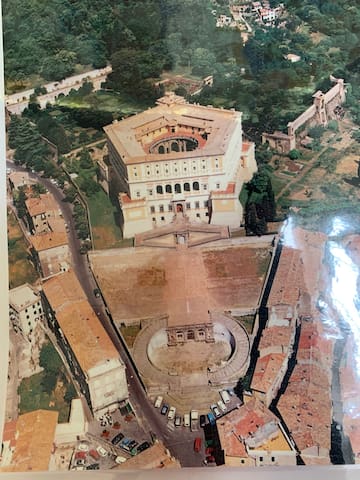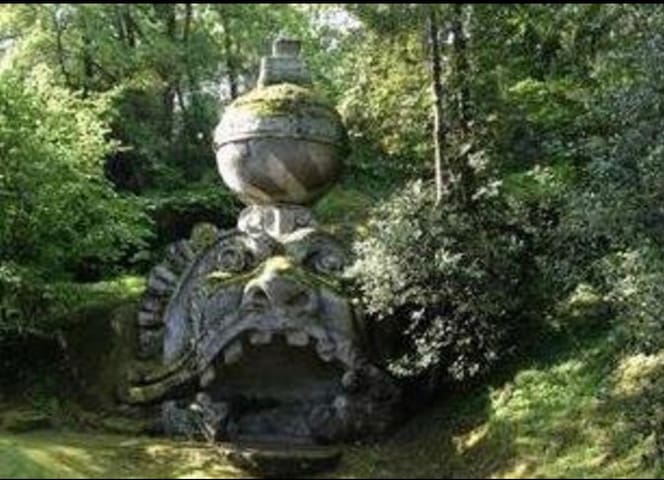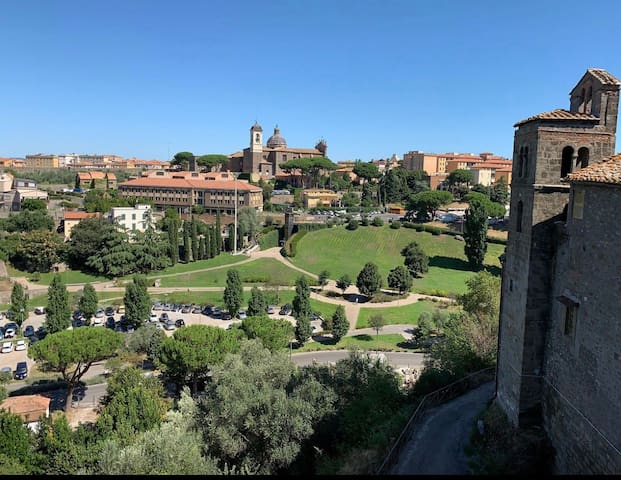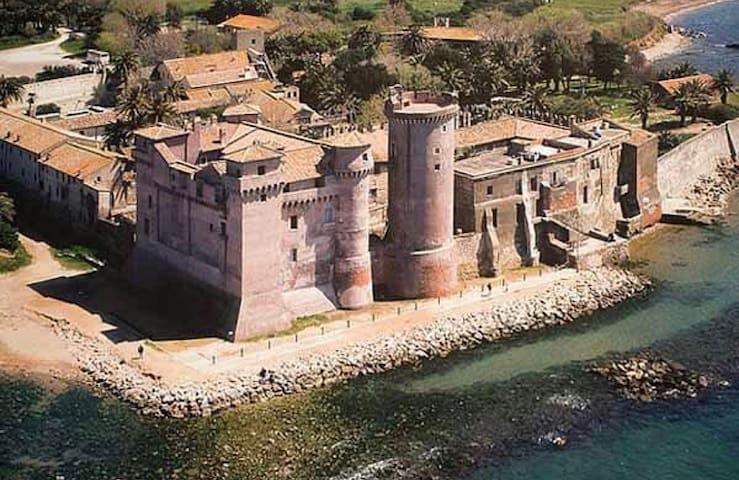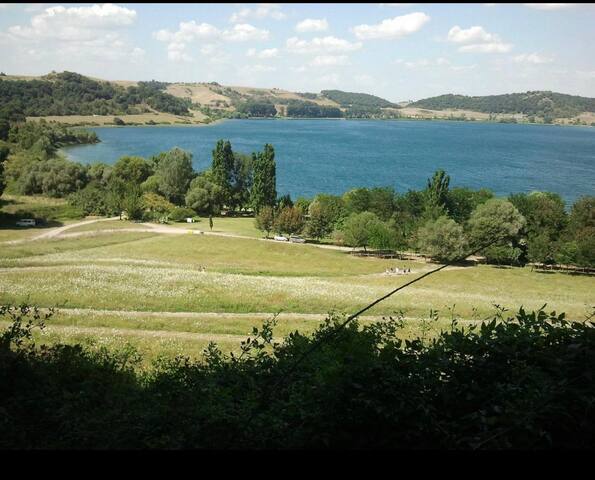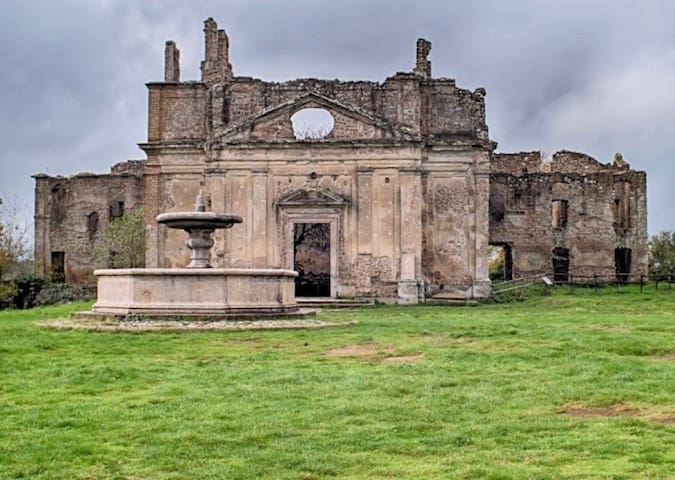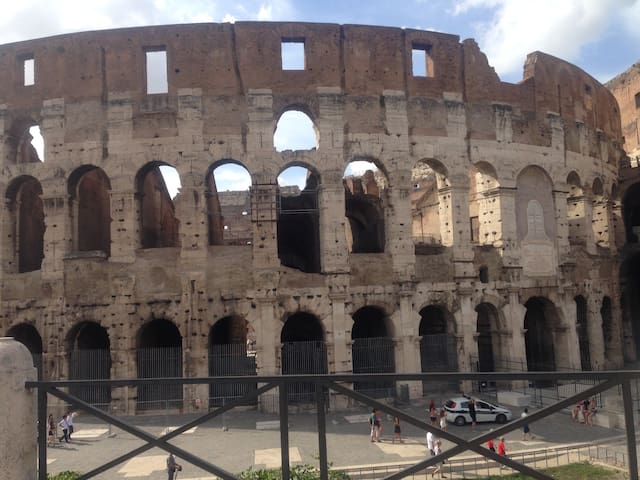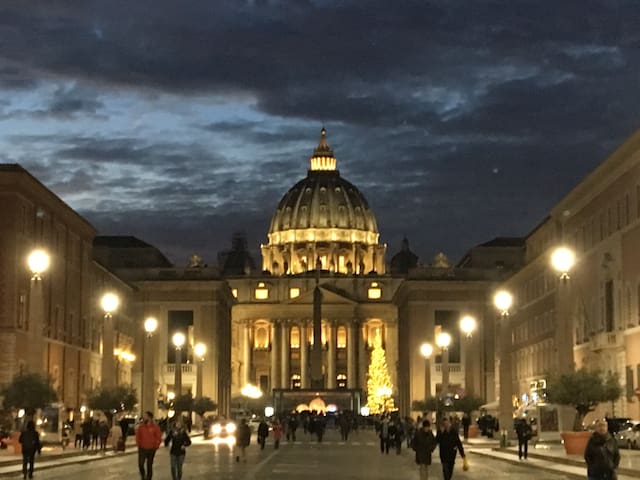Sightseeing
The ancient and somewhat mysterious town of Sutri, about a 25 minute drive away, boasts a spectacular Roman amphitheatre excavated in the tuffo rock, an Etruscan necropolis with dozens of tombs cut out of rock, a Mithraeum incorporated in the crypt of its church of the Madonna del Parto, and a Romanesque Duomo. Be sure to visit the archeological area off the main road (Cassia) and stroll along the footpaths that go into the countryside to see some of the extraordinary tombs and grottos.
Throughout the year, Sutri holds a series of cultural events and in summer hosts an outdoor medieval festival.
46 Recomendado por los habitantes de la zona
Sutri
The ancient and somewhat mysterious town of Sutri, about a 25 minute drive away, boasts a spectacular Roman amphitheatre excavated in the tuffo rock, an Etruscan necropolis with dozens of tombs cut out of rock, a Mithraeum incorporated in the crypt of its church of the Madonna del Parto, and a Romanesque Duomo. Be sure to visit the archeological area off the main road (Cassia) and stroll along the footpaths that go into the countryside to see some of the extraordinary tombs and grottos.
Throughout the year, Sutri holds a series of cultural events and in summer hosts an outdoor medieval festival.
The 16th century Farnese Palace, also known as Villa Farnese, is a pentagonal mansion in the town of Caprarola in the province of Viterbo, Northern Lazio, Italy, approximately 50 kilometres (31 mi) north-west of Rome. This villa should not be confused with the Palazzo Farnese and the Villa Farnesina, both in Rome.
From its hilltop position, Villa Farnese dominates the town of Caprarola and its surroundings. It is a massive Renaissance and Mannerist construction built on a five-sided plan in reddish gold stone.
In 1504, Cardinal Alessandro Farnese, the future Pope Paul III, acquired the estate at Caprarola and hired the architects Antonio da Sangallo the Younger and Baldassare Peruzzi to draw up plans for a fortified castle.
After the desth if Sangallo some years later, the younger Cardinal Alessandro Farnese, a grandson of Pope Paul III, decided to turn the partly constructed fortified edifice into a country house. In 1556, he commissioned Giacomo Barozzi da Vignola as his architect. Construction work commenced in 1559 and Vignola continued to work on the villa at Caprarola until his death in 1573.
The Villa is decorated with splendid frescoes throughout, a magnificent spiral staircase and breathtaking renaissance gardens filled with waterfalls and statuary.
86 Recomendado por los habitantes de la zona
Villa Farnese
1 Piazza FarneseThe 16th century Farnese Palace, also known as Villa Farnese, is a pentagonal mansion in the town of Caprarola in the province of Viterbo, Northern Lazio, Italy, approximately 50 kilometres (31 mi) north-west of Rome. This villa should not be confused with the Palazzo Farnese and the Villa Farnesina, both in Rome.
From its hilltop position, Villa Farnese dominates the town of Caprarola and its surroundings. It is a massive Renaissance and Mannerist construction built on a five-sided plan in reddish gold stone.
In 1504, Cardinal Alessandro Farnese, the future Pope Paul III, acquired the estate at Caprarola and hired the architects Antonio da Sangallo the Younger and Baldassare Peruzzi to draw up plans for a fortified castle.
After the desth if Sangallo some years later, the younger Cardinal Alessandro Farnese, a grandson of Pope Paul III, decided to turn the partly constructed fortified edifice into a country house. In 1556, he commissioned Giacomo Barozzi da Vignola as his architect. Construction work commenced in 1559 and Vignola continued to work on the villa at Caprarola until his death in 1573.
The Villa is decorated with splendid frescoes throughout, a magnificent spiral staircase and breathtaking renaissance gardens filled with waterfalls and statuary.
The 16th century Villa Lante is formed by two nearly identical casini (houses) and an ornate garden filled with cascades, fountains, dripping grottoes and statuary.
The first of the two Mannerist style casini was commissioned by Cardinal Gianfrancesco Gambara who asked Giacomo Barozzi da Vignola to also design and begin work on the gardens for which the villa was to become famous.
It appears that work commenced in the late 1560s on the right-hand casino (as one enters).
The first casino and upper garden were quickly completed, but work was then suspended for the remainder of Gambara's lifetime.
Gambara died in 1587 and was succeeded by the 17-year-old nephew of Pope Sixtus V, Cardinal Alessandro Peretti di Montalto. It was this mere youth who completed the project at Bagnaia and built the second casino.
101 Recomendado por los habitantes de la zona
Villa Lante
71 Via Jacopo BarozziThe 16th century Villa Lante is formed by two nearly identical casini (houses) and an ornate garden filled with cascades, fountains, dripping grottoes and statuary.
The first of the two Mannerist style casini was commissioned by Cardinal Gianfrancesco Gambara who asked Giacomo Barozzi da Vignola to also design and begin work on the gardens for which the villa was to become famous.
It appears that work commenced in the late 1560s on the right-hand casino (as one enters).
The first casino and upper garden were quickly completed, but work was then suspended for the remainder of Gambara's lifetime.
Gambara died in 1587 and was succeeded by the 17-year-old nephew of Pope Sixtus V, Cardinal Alessandro Peretti di Montalto. It was this mere youth who completed the project at Bagnaia and built the second casino.
A park filled with crazy monster statues in Bomarzo, not far from Villa Lante in Bagnaia. Great fun to explore!
The garden design is attributed to Pirro Ligorio who created the rambling Mannerist park during the 16th century. The sculptures are attributed to Simone Moschino. Situated in a wooded valley beneath the Orsini castle, it is populated by grotesque sculptures and small buildings located among the natural vegetation.
The park was commissioned by Pier Francesco Orsini, a patron of the arts, greatly devoted to his wife Giulia. When Orsini's wife died, he created the gardens to cope with his grief.
During the 19th century, and deep into the 20th, the garden became overgrown and neglected, but after the Spanish painter Salvador Dalí made a short movie about the park, and completed a painting based on it in the 1950s, the owners brought it back to its original splendor.
Throughout the years, the park has appeared in numerous films and inspired the works of many authors and poets.
200 Recomendado por los habitantes de la zona
Parque de los Monstruos
Località GiardinoA park filled with crazy monster statues in Bomarzo, not far from Villa Lante in Bagnaia. Great fun to explore!
The garden design is attributed to Pirro Ligorio who created the rambling Mannerist park during the 16th century. The sculptures are attributed to Simone Moschino. Situated in a wooded valley beneath the Orsini castle, it is populated by grotesque sculptures and small buildings located among the natural vegetation.
The park was commissioned by Pier Francesco Orsini, a patron of the arts, greatly devoted to his wife Giulia. When Orsini's wife died, he created the gardens to cope with his grief.
During the 19th century, and deep into the 20th, the garden became overgrown and neglected, but after the Spanish painter Salvador Dalí made a short movie about the park, and completed a painting based on it in the 1950s, the owners brought it back to its original splendor.
Throughout the years, the park has appeared in numerous films and inspired the works of many authors and poets.
Oriolo Romano is a short drive away and is home to the 16th century Palazzo Altieri which belonged to the Roman noble family of that name. Though some say it is the creation of 16th-century Italian architect Il Vignola, it’s likely less famous architects were responsible for its construction. Work on the building was completed by Carlo Fontana in the late 17th century.
Today, 14 rooms can be visted. Most are decorated with beautiful frescoes. Be sure to check out the late 18th-century dining hall with its views of the Altieri fiefdoms.
The Palazzo is probably most renowned for its complete gallery full of portraits of the popes, from Saint Peter to Pope Francis. The collection presents each pope’s portrait with his papal coat of arms, his motto, and a description in Latin of his deeds.
7 Recomendado por los habitantes de la zona
Oriolo Romano
Oriolo Romano is a short drive away and is home to the 16th century Palazzo Altieri which belonged to the Roman noble family of that name. Though some say it is the creation of 16th-century Italian architect Il Vignola, it’s likely less famous architects were responsible for its construction. Work on the building was completed by Carlo Fontana in the late 17th century.
Today, 14 rooms can be visted. Most are decorated with beautiful frescoes. Be sure to check out the late 18th-century dining hall with its views of the Altieri fiefdoms.
The Palazzo is probably most renowned for its complete gallery full of portraits of the popes, from Saint Peter to Pope Francis. The collection presents each pope’s portrait with his papal coat of arms, his motto, and a description in Latin of his deeds.
Viterbo is about a 45 minute drive north along the old Cassia road. The Palazzo dei Papi, a palace with an elegant loggia, was the seat of the popes in the 13th century. Nearby is San Lorenzo Cathedral, with a Gothic bell tower, frescoes and a 15th-century baptismal font. The Colle del Duomo Museum houses archaeological artifacts and a sacred art collection. The frescoed Palazzo dei Priori, Viterbo’s city hall, is on Piazza del Plebiscito.
As a settlement Viterbo dates back to Etruscan times. Between around 1100 and 1300, it was one of the most important cities in Europe. By the 13th century it had 50 castles under its control. It was the place where popes took refuge when driven out of Rome and for several decades was the seat of the Papacy. It was the scene of battles between potential invaders of Rome and papal armies.
With the departure of the Papacy to Orvieto and then to Avignon, Viterbo declined in importance. It was further hit by Black Death, which killed two-thirds of its population and a major earthquake in 1349. In the 20th century it was damaged by Allied bombs. Today, its population is about the same as it was in the 13th century, at around 60,000.
For the spectacular Festa di Santa Rosa, the festival of the city’s patron saint on September 2 and 3 each year, the city gathers in processions which culminate on the night of September 3 when one hundred facchini, or strongmen, carry a 90-foot tall, four-ton macchina – an obelisk-shaped statue – of Santa Rosa through the winding streets of the city. The 750 year-long tradition has seen the statue become progressively larger and heavier until the 19th century, when the macchina toppled over, crushing facchini and spectators alike. Not to worry, however: a disaster has not happened since, although it is still said that the facchini must sign their wills before they can bear the weight of the macchina. The macchina, illuminated against the night sky, is truly an incredible sight - people begin staking out their places to watch the procession early in the morning so be prepared!
204 Recomendado por los habitantes de la zona
Viterbo
Viterbo is about a 45 minute drive north along the old Cassia road. The Palazzo dei Papi, a palace with an elegant loggia, was the seat of the popes in the 13th century. Nearby is San Lorenzo Cathedral, with a Gothic bell tower, frescoes and a 15th-century baptismal font. The Colle del Duomo Museum houses archaeological artifacts and a sacred art collection. The frescoed Palazzo dei Priori, Viterbo’s city hall, is on Piazza del Plebiscito.
As a settlement Viterbo dates back to Etruscan times. Between around 1100 and 1300, it was one of the most important cities in Europe. By the 13th century it had 50 castles under its control. It was the place where popes took refuge when driven out of Rome and for several decades was the seat of the Papacy. It was the scene of battles between potential invaders of Rome and papal armies.
With the departure of the Papacy to Orvieto and then to Avignon, Viterbo declined in importance. It was further hit by Black Death, which killed two-thirds of its population and a major earthquake in 1349. In the 20th century it was damaged by Allied bombs. Today, its population is about the same as it was in the 13th century, at around 60,000.
For the spectacular Festa di Santa Rosa, the festival of the city’s patron saint on September 2 and 3 each year, the city gathers in processions which culminate on the night of September 3 when one hundred facchini, or strongmen, carry a 90-foot tall, four-ton macchina – an obelisk-shaped statue – of Santa Rosa through the winding streets of the city. The 750 year-long tradition has seen the statue become progressively larger and heavier until the 19th century, when the macchina toppled over, crushing facchini and spectators alike. Not to worry, however: a disaster has not happened since, although it is still said that the facchini must sign their wills before they can bear the weight of the macchina. The macchina, illuminated against the night sky, is truly an incredible sight - people begin staking out their places to watch the procession early in the morning so be prepared!
Santa Severa’s Castle is one of the most evocative places of the Lazio region, located along the Tyrrhenian coast north of Rome. The Castle owes its current name to the young Christian martyr Severa, who according to tradition, was killed on June 5, 298 AD in this place, together with her brothers Calendino and Marco, during the Diocletian empire.
The area dates back to ancient times and the first archeological findings have been traced to the Bronze Age, when people settled here thanks to freshwater springs.
In the VII century A. C. Pyrgi was built between the most important sea ports of the whole Etruria, only 13 Km away from the powerful Caere – later known as Cerveteri – of which it was the main port. The Etruscan settlement then became the seat, in first half of the III century, of a Roman colony (Castrum) whose remains are present in the fortification walls.
During the Imperial age it was transformed from a military camp into a residence for wealthy Roman families who owned luxurious seaside villas. A vast cemetery extends over the remains of buildings from the Roman Era and Late Antiquity, starting at least from the IX century and presumably used until the XIII-XIV century.
The structure of the real Castle, however, dates back to the XIV century. A moat surrounded the structure, with a rectangular plan with corner towers, and connected it by a wooden bridge to the imposing cylindrical fortification, the “Maschio”, formerly called “La Torre del Castello”. Pope Leo X built it in the mid-ninth century and, following further reconstruction, it continues to this day in its XVI-XVII century structure.
The first written documentation of the castle dates back to 1068, when Gerardo di Galeria – a Count of Norman origin – donated the Castle and the Church to the Abbey of Farfa that in 1130, under Pope Anacletus II, gave it to the confreres of St. Paul. In 1482 Pope Sixtus IV donated it to the Order of the Holy Spirit, who owned it for five hundred years, until 1980.
It was during this period, under the aegis of Santo Spirito, that the village came to life (between the XV and XVI centuries) and in the entire place, the typical coat of arms of the Order is visible: the patriarchal cross.
The Germans used the Castle as a strategic base during the Second World War.
Today the structure hosts a museum and frequent cultural events, including a Christmas village.
32 Recomendado por los habitantes de la zona
Santa Severa
Santa Severa’s Castle is one of the most evocative places of the Lazio region, located along the Tyrrhenian coast north of Rome. The Castle owes its current name to the young Christian martyr Severa, who according to tradition, was killed on June 5, 298 AD in this place, together with her brothers Calendino and Marco, during the Diocletian empire.
The area dates back to ancient times and the first archeological findings have been traced to the Bronze Age, when people settled here thanks to freshwater springs.
In the VII century A. C. Pyrgi was built between the most important sea ports of the whole Etruria, only 13 Km away from the powerful Caere – later known as Cerveteri – of which it was the main port. The Etruscan settlement then became the seat, in first half of the III century, of a Roman colony (Castrum) whose remains are present in the fortification walls.
During the Imperial age it was transformed from a military camp into a residence for wealthy Roman families who owned luxurious seaside villas. A vast cemetery extends over the remains of buildings from the Roman Era and Late Antiquity, starting at least from the IX century and presumably used until the XIII-XIV century.
The structure of the real Castle, however, dates back to the XIV century. A moat surrounded the structure, with a rectangular plan with corner towers, and connected it by a wooden bridge to the imposing cylindrical fortification, the “Maschio”, formerly called “La Torre del Castello”. Pope Leo X built it in the mid-ninth century and, following further reconstruction, it continues to this day in its XVI-XVII century structure.
The first written documentation of the castle dates back to 1068, when Gerardo di Galeria – a Count of Norman origin – donated the Castle and the Church to the Abbey of Farfa that in 1130, under Pope Anacletus II, gave it to the confreres of St. Paul. In 1482 Pope Sixtus IV donated it to the Order of the Holy Spirit, who owned it for five hundred years, until 1980.
It was during this period, under the aegis of Santo Spirito, that the village came to life (between the XV and XVI centuries) and in the entire place, the typical coat of arms of the Order is visible: the patriarchal cross.
The Germans used the Castle as a strategic base during the Second World War.
Today the structure hosts a museum and frequent cultural events, including a Christmas village.
The borgo of Ronciglione, about a half hour drive away, appears to have been founded around 1045. It is perched on a hilltop overlooking a gorge that cuts through the tuffo rock. Later it was a possession of the Anguillara, a Guelph family of Rome. Pope Paul II conquered it to the Papal States in 1465.
Today Ronciglione boasts one of Italy’s most spectacular Carnevals marking the beginning of Lent, usually in February or early March each year.
From 1526 to1649, Ronciglione was a possession of the Farnese, and lived its period of greatest splendour: its industries included manufacturing of copper, iron, paper, weapons and other goods.
The Ronciglionesi took an active part in the Roman Republic of 1798–99: the French troops, however, crushed the revolt and burnt the city on July 20, 1799.
Ronciglione station
The borgo of Ronciglione, about a half hour drive away, appears to have been founded around 1045. It is perched on a hilltop overlooking a gorge that cuts through the tuffo rock. Later it was a possession of the Anguillara, a Guelph family of Rome. Pope Paul II conquered it to the Papal States in 1465.
Today Ronciglione boasts one of Italy’s most spectacular Carnevals marking the beginning of Lent, usually in February or early March each year.
From 1526 to1649, Ronciglione was a possession of the Farnese, and lived its period of greatest splendour: its industries included manufacturing of copper, iron, paper, weapons and other goods.
The Ronciglionesi took an active part in the Roman Republic of 1798–99: the French troops, however, crushed the revolt and burnt the city on July 20, 1799.
13.5 kms long and 12 kms in diameter, the lake of Bolsena is Europe’s largest lake of volcanic origin. It lies north of Viterbo and is not far from Civita’ di Bagnoreggio but I believe each deserves a full day excursion with a relaxing lunch at one of their many restaurants.
To get to the lake, you’ll probably pass through the town of Montefiascone, known for its crisp white wine, Est! Est! Est!
The Castle or Rocca of Bolsena and its old borgo are delightful, with an interesting museum, shops and restaurants. You can also stroll along the marina, have lunch or an aperatif there or hire a boat for the day.
There are two private islands on the lake, Martana and Bisentina which owe their history to a succession of noble families, cardinals and popes. Bisentina, the larger of the two, is rich in vegetation and scattered around the island there are seven small chapels. The finest is the octagonal Tempietto di Santa Caterina which is visible from the shore.
Some years ago, the wreckage of a U.S. bomber plane that crashed in the lake in January, 1944 was recovered. The name of a woman written on the side of the plane led a scholar from Viterbo to trace the aircraft to the machine gunner, Sergeant Rulf Truesdale, and the entire 10 man crew. In 2013, local authorities invited the family of the American sergeant to visit Lake Bolsena with which they have established a deep bond and often return to visit. The plane turret is now kept in the Bolsena Museum.
Bolsena is also known for the Miracle of the Eucharist which took place in 1263 when, at the moment of consecration during mass, the host began to bleed in the hands of the priest. Shaken, the clergyman wrapped the Eucharist in his robes and presented it to Pope Urban IV in Orvieto who later proclaimed the miracle and instituted the Solemnity of Corpus Domini celebrating Christ’s true presence in the Eucharist. The miracle was depicted in the ‘Mass in Bolsena’ by Raphael in one of his Stanzas in the Vatican in 1512.
Bolsena celebrates the feast of Santa Cristina of Bolsena with a series of religious processions and events on July 23 and 24 each year.
243 Recomendado por los habitantes de la zona
Lago Bolsena
13.5 kms long and 12 kms in diameter, the lake of Bolsena is Europe’s largest lake of volcanic origin. It lies north of Viterbo and is not far from Civita’ di Bagnoreggio but I believe each deserves a full day excursion with a relaxing lunch at one of their many restaurants.
To get to the lake, you’ll probably pass through the town of Montefiascone, known for its crisp white wine, Est! Est! Est!
The Castle or Rocca of Bolsena and its old borgo are delightful, with an interesting museum, shops and restaurants. You can also stroll along the marina, have lunch or an aperatif there or hire a boat for the day.
There are two private islands on the lake, Martana and Bisentina which owe their history to a succession of noble families, cardinals and popes. Bisentina, the larger of the two, is rich in vegetation and scattered around the island there are seven small chapels. The finest is the octagonal Tempietto di Santa Caterina which is visible from the shore.
Some years ago, the wreckage of a U.S. bomber plane that crashed in the lake in January, 1944 was recovered. The name of a woman written on the side of the plane led a scholar from Viterbo to trace the aircraft to the machine gunner, Sergeant Rulf Truesdale, and the entire 10 man crew. In 2013, local authorities invited the family of the American sergeant to visit Lake Bolsena with which they have established a deep bond and often return to visit. The plane turret is now kept in the Bolsena Museum.
Bolsena is also known for the Miracle of the Eucharist which took place in 1263 when, at the moment of consecration during mass, the host began to bleed in the hands of the priest. Shaken, the clergyman wrapped the Eucharist in his robes and presented it to Pope Urban IV in Orvieto who later proclaimed the miracle and instituted the Solemnity of Corpus Domini celebrating Christ’s true presence in the Eucharist. The miracle was depicted in the ‘Mass in Bolsena’ by Raphael in one of his Stanzas in the Vatican in 1512.
Bolsena celebrates the feast of Santa Cristina of Bolsena with a series of religious processions and events on July 23 and 24 each year.
Civita di Bagnoregio
Lake Vico
Lake Martignano is a small natural lake about 15 minutes away and is ideal for picnics along its grassy shores. There is a farmhouse restaurant which can be reached by getting off the Cassia bis at Campagnano.
Alternatively, on the opposite side of the lake, for those who don’t mind a hike down (and back up) the steep hill, a rough track leads from the Trevignano- Anguillara road to a parking area - i think there’s a fee to be paid. Follow signs to Martignano.
93 Recomendado por los habitantes de la zona
Lake Martignano
Lake Martignano is a small natural lake about 15 minutes away and is ideal for picnics along its grassy shores. There is a farmhouse restaurant which can be reached by getting off the Cassia bis at Campagnano.
Alternatively, on the opposite side of the lake, for those who don’t mind a hike down (and back up) the steep hill, a rough track leads from the Trevignano- Anguillara road to a parking area - i think there’s a fee to be paid. Follow signs to Martignano.
Canale Monterano
Rome
Vatican City


